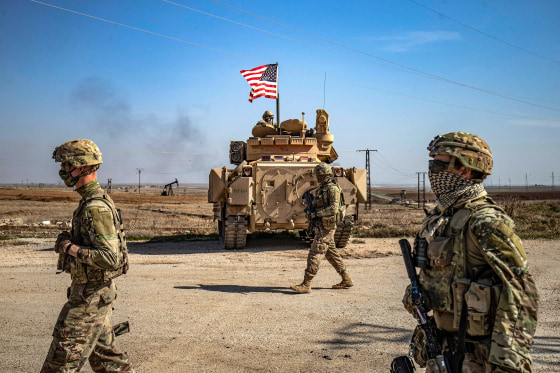
Two U.S. defense sources told NBC News Tuesday that the Defense Department is creating plans to remove all U.S. forces from Syria.
Pentagon officials started creating preparations for a complete departure in 30, 60, or 90 days after President Donald Trump and his advisers recently showed interest in removing American forces from Syria, according to the individuals.
According to U.S. defense officials, Mike Waltz, Trump’s new national security advisor, met with senior U.S. military personnel and received briefings on the Middle East at U.S. Central Command headquarters in Tampa, Florida, on Friday.
According to a White House official, Waltz’s visit and the briefing did not address the possibility of a drawdown in U.S. soldiers in Syria.
The White House official noted that Jordan’s King Abdullah is expected to come next week and that Israeli Prime Minister Benjamin Netanyahu visited the White House on Tuesday, saying it’s excellent for NSA Waltz to visit CENTCOM to get a sense of the overall region.
A Pentagon official chose not to comment.
At a media session held at the Oval Office last Thursday, a reporter questioned Trump regarding rumors that he had told the Israeli government that the United States was considering withdrawing its soldiers from Syria.
I have no idea who said it. Actually, I have no idea who said that, but we’ll decide that. Trump responded, “We’re not getting, we’re not involved in Syria.” Syria is a disaster in and of itself. There are already enough messes there. They don’t require our involvement in every situation.
Trump gave Defense Secretary James Mattis an order to remove all American forces from Syria at the end of 2019. Mattis quit in protest after pushing back against the concept.
The majority of U.S. forces were withdrawn by Trump, but they were later moved back. Since then, the United States has maintained its presence in Syria.
The Pentagon declared in December that nearly 2,000 troops had been sent to Syria, more than twice as many as the military has claimed for years (about 900).
While the 900 were core troops stationed there for more than a year, the extra 1,100 troops were temporary rotational forces for roughly 30 to 90 days at a period, according to a Pentagon spokesman.
U.S. mission in Syria
According to the Pentagon, the military’s goal in Syria is to weaken the terrorist organization known as Islamic State and assist regional allies who are active there. To prevent ISIS from reestablishing a safe haven, they include the Syrian Democratic Forces, a combination of militias and rebel organizations dominated by Kurds.
A leader of Hurras al-Din, an Al Qaeda offshoot, was the target of a precision attack carried out by CENTCOM in northwest Syria on Thursday. Muhammad Salah al-Zabir was characterized by defense officials as a senior Hurras al-Din agent.
Defense officials caution that withdrawing American forces from Syria would be a betrayal of the Syrian Democratic Forces and jeopardize the safety of over two dozen jails and camps for refugees that house over 50,000 individuals, including over 9,000 ISIS terrorists.
Although the facilities, which house men, women, and children, are secured by the Syrian Democratic Forces, they are maintained by funding and assistance from the United States and its allies.
The Syrian Democratic Forces may focus on offensive operations and leave the camps and prisons without American forces to help military and detention operations, releasing thousands of ISIS fighters.
In December, Bashar al-Assad’s government was overthrown by rebel forces known as Hayat Tahrir al-Sham. Jabhat al-Nusra, also known as the Nusra Front, is a branch of Al Qaeda that operates in Syria. It gave rise to HTS, a coalition of Sunni Islamist insurgent groups with a stronghold in Syria.
Following the overthrow of Assad’s government, Ahmed al-Sharaa, formerly known as Abu Mohammad al-Jolani, the leader of HTS, emerged as Syria’s de facto leader.
The first formal diplomatic encounter between U.S. and Syrian officials in over a decade took place in late December, when al-Sharaa and other HTS members met with senior Biden administration officials.
Al-Sharaa has promised to hold elections and provide an inclusive government as part of a political transition that might take up to four years.
